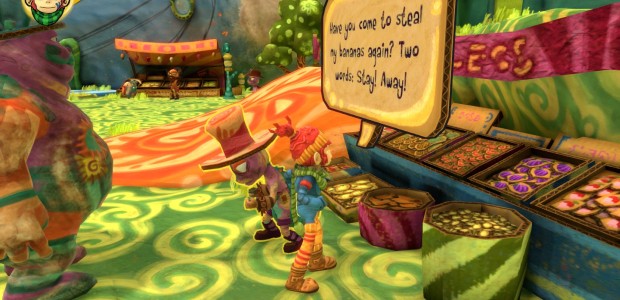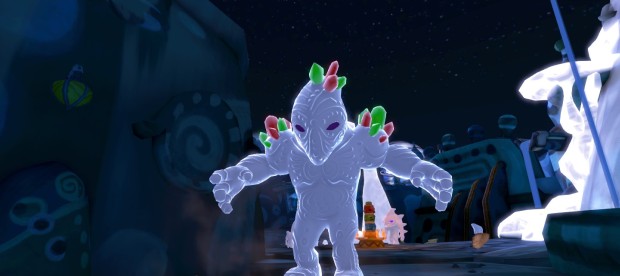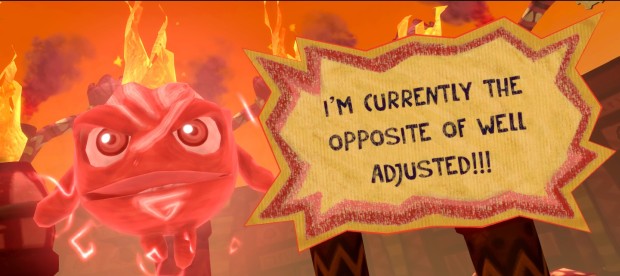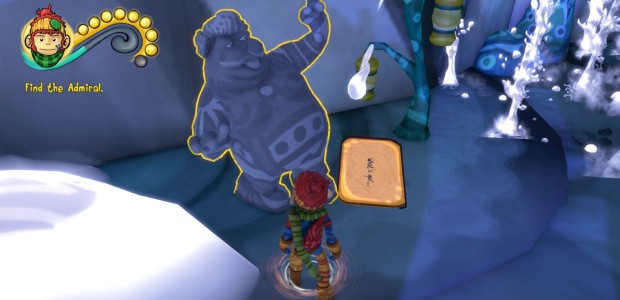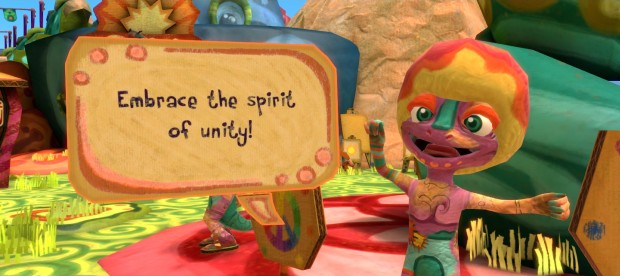Wot I Think - The Last Tinker: City Of Colors
Tinker Failure Told-ya Why
I was actively discouraged from enjoying my favourite moment of The Last Tinker. An unseen enemy bombarded me as I tried to absorb some excellent set-dressing. Though the game’s pitched as a childish platforming adventure, revelling in a bright storybook aesthetic, this particular bit of the world is not for me to enjoy. I’m being shooed away. You’ve got more art to see. Into the next room please, sir, you’re holding up the tour.
The City Of Colors is home to primary-pigmented animals who’ve all turned on each other for Reasons Unknown But You’ll Find Out Later. Anything in this land can be created by applying paint to card, but production of usable colour is halted because no one from any of the city's districts can get along. This concept is a little underutilised in the game’s art design. Mostly everything has a florid clay look, like baked play-dough, but a few textures appear as drawings. Prominently: any time an NPC speaks, their dialogue exists as a physical canvas suspended in the air. You can walk around their speech bubble like it’s tangible. It implies something great about this world, that everything has a context outside of the story you’re being told, as if it’s all the project of an imaginative 8-year-old completely earning their inevitable scholarship.
This moment I’m talking about: you come across a character who has long-since become petrified mid-dialogue. His Colour was washed out by The Baddie who can Do That because Plot and that makes people into Statues. A speech bubble has fallen to the floor, with a half-finished sentence cut off by the transformation.
I wanted to walk around this area, get a feel for what he was doing when this happened. I wanted a better look at his expression. I wanted to think more about this lending context to the rest of the game. But I was being shot by something I couldn’t see and was going to die if I didn’t get a wriggle on. As if I shouldn’t pay too much attention to this. What I should be doing is making progress, killing the enemy further into the level and trekking on to the next Thing.
And that’s basically indicative of The Last Tinker’s failings from every angle. It seems unfocused, unconfident in any one idea; as if it hopes a passive mixture of different influences cycled through very quickly will make up for the lack of depth in any one of them.
It’s sort-of a platformer, but with strict limits on when you’re allowed to jump. Like a less creative Prince Of Persia wearing a brighter shirt. The few better parts of this involve trial-and-error timing with only briefly available footholds, but mostly it’s indifferent to regular movement. Platforming usually implies that there's a challenge in precision, but here you're locked to whatever you jump on until you move to the next bit of land. That technically makes platforming less stressful than just walking.
It’s part puzzle game too, a bit, since instead of really asking you to figure anything out you’re simply introduced to a new concept in a vacuum and then asked to prove you understand without ever being particularly puzzled or it fully capitalising or subverting ideas it’s already introduced. In these segments you’re aided by a partner, a sentient mushroom who follows you at your behest and performs different actions when they come into contact with the colours you collect. Each of these sections are practically the same, but as rhyme rather than repetition. Every time you’ll see a blocked path, every time you’ll see this friend further into the level, you’ll collect them from one area, escorting them to another, then use them as a way to unblock a path with whichever newest colour you’ve picked up. Where a real puzzle would be figuring out how to design the key to get through a door, here you’re given the key and don’t even get to pick out which novelty chain it’s going to be attached to.
There’s combat, which becomes more interesting with each encounter but stops short before reaching even the base-level complexity of an Arkham Asylum. Initially you perform single button attacks against conjured, whited-out monsters who are smaller but outnumber you. They then grow bulkier and slower in each new section, while you gain different punches on separate buttons which confer colour-based-status-effects. Two enemy types are later introduced which both act as walking signs that say “hit me first”; one that automatically kills you if not taken care of immediately, the other who confers a shield to every other assailant. The game’s best enemy is a monster which can only be damaged by colours that it doesn’t currently have adorning its shoulders. It prevents you from just hammering the regular attack button on the thing you most want to die, but it’s introduced too late to make the majority of combat particularly interesting.
Maybe all of this simplistic design is a concession for the audience, which I assume is going to consist of children and me as the single outlier. It’s stripped down as an attempt to be accessible, perhaps as a decent choice for the very first introduction someone has to a third-person-video game. My complaint, though, isn’t that The Last Tinker is easy, it’s just that it’s dull.
You know the first hour of Brothers: A Tale Of Two Sons? How it’s all just about getting you used to the controls, then the rest can fully explore what its few systems mean with brief alterations which are interesting, then are never repeated? The Last Tinker reverses that. It’s mostly introduction, the systems briefly returning in different ways which hardly differ from the previous time and never justify their own inclusion.
And you know how Papo Y Yo is all about the relationship between the character and the monster? And the mechanics are constantly developing on that tense thread of dependence, but in a different context that support system is also the player’s greatest source of danger? The Last Tinker is a hero's journey. The characters have a call to action and collect the necessary boons to overcome the personal obstacles along with the literal one. None of that meshes with your activity, where you can shoot colours to make a mushroom guy Do A Thing.
But that doesn’t mean it’s entirely without charm. The world is wonderful to inhabit, just not to actually do anything within. There’s colour! It’s everywhere! If you look up in the sky the sun is anthropomorphised and will give you a cheery wave! At night time it's all sleepy and adorable! There’s so much animation for all of the city’s NPCs! The Last Tinker is mechanically uninteresting to the point where it’s impossible to recommend, but being there, wandering around, properly taking in everything I’m allowed without being moved along, that's where it's noteworthy.

